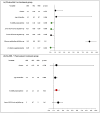GH receptor polymorphisms guide second-line therapies to prevent acromegaly skeletal fragility: preliminary results of a pilot study
- PMID: 39280003
- PMCID: PMC11395836
- DOI: 10.3389/fendo.2024.1414101
GH receptor polymorphisms guide second-line therapies to prevent acromegaly skeletal fragility: preliminary results of a pilot study
Abstract
Background: Skeletal fragility is characterized by increased frequency of vertebral fractures (VFs) in acromegaly. Several trials were conducted to identify modifiable risk factors and predictors of VFs, with limited data on the prognostic role of GH receptor (GHR) isoforms. In this study, we investigated the potential role of GHR polymorphism on the occurrence of incidental VFs (i-VFs), in patients treated with second-line medical therapies.
Methods: A longitudinal, retrospective, observational study was conducted on a cohort of 45 acromegalic patients not-responsive to first-generation somatostatin receptor ligands (fg-SRLs) and treated with GHR antagonist (Pegvisomant) or with the second-generation SRLs (Pasireotide long-acting release).
Results: Second line treatments were Pegvisomant plus fg-SRLs in 26 patients and Pasireotide LAR in 19 patients. From the group treated with fg-SRLs+Peg-V, the fl-GHR isoform was identified in 18 patients (69.2%) and the d3-GHR isoform in 8 patients (30.8%). I-VFs arose exclusively in fl-GHR isoform carriers (p=0.039). From the group treated with Pasireotide LAR, the fl-GHR isoform was identified in 11 patients (57.9%), and the d3-GHR isoform in 8 patients (42.1%). I-VFs arose exclusively in d3-GHR isoform carriers (p=0.018). Patients with fl-GHR isoform had a higher risk for i-VFs if treated with fg-SRL+Peg-V (OR: 1.6 95%IC: 1.1-2.3, p=0.04), and a lower risk if treated with Pasi-LAR (OR: 0.26 IC95%: 0.11-0.66, p=0.038).
Conclusions: Our data support a predictive role of the GHR isoforms for the occurrence of i-VFs in acromegalic patients treated with second-line drugs, tailored to the individual patient. The knowledge of the GHR polymorphism may facilitate the choice of second-line therapies, improving the therapeutic approach, in the context of personalized medicine.
Keywords: GH receptor; acromegaly; fracture; osteopenia; osteoporosis; pasireotide; pegvisomant; somatostatin receptor ligands.
Copyright © 2024 Chiloiro, Costanza, Giampietro, Infante, Mattogno, Angelini, Gullì, Lauretti, Rigante, Olivi, De Marinis, Doglietto, Bianchi and Pontecorvi.
Conflict of interest statement
SC, AB, AG, LDM have served as investigator for clinical trials funded by Novartis, Pfizer, Ipsen and Crinetics. SC and AB received grants from Pfizer. SC won the 2022 Arrigo Recordati Research Grant. The remaining authors declare that the research was conducted in the absence of any commercial or financial relationships that could be construed as a potential conflict of interest.
Figures
Similar articles
-
Bone health and skeletal fragility in second- and third-line medical therapies for acromegaly: preliminary results from a pilot single center experience.Pituitary. 2024 Jun;27(3):303-309. doi: 10.1007/s11102-024-01398-9. Epub 2024 May 7. Pituitary. 2024. PMID: 38713317
-
The Role of the GH Receptor Polymorphisms as a Prognostic Factor of Vertebral Fractures in Acromegalic Patients Resistant to First-generation SSAs and Treated with Pegvisomant or Pasireotide LAR.Endocr Metab Immune Disord Drug Targets. 2024 Jul 5. doi: 10.2174/0118715303322301240610111946. Online ahead of print. Endocr Metab Immune Disord Drug Targets. 2024. PMID: 38982703
-
Pegvisomant and Pasireotide LAR as second line therapy in acromegaly: clinical effectiveness and predictors of response.Eur J Endocrinol. 2021 Feb;184(2):217-229. doi: 10.1530/EJE-20-0767. Eur J Endocrinol. 2021. PMID: 33136550
-
The Role of Growth Hormone Receptor Isoforms and Their Effects in Bone Metabolism and Skeletal Fragility.Protein Pept Lett. 2020;27(12):1260-1267. doi: 10.2174/0929866527666200616151105. Protein Pept Lett. 2020. PMID: 32543356 Review.
-
Pasireotide: a novel treatment for patients with acromegaly.Drug Des Devel Ther. 2016 Jan 11;10:227-39. doi: 10.2147/DDDT.S77999. eCollection 2016. Drug Des Devel Ther. 2016. PMID: 26811671 Free PMC article. Review.
Cited by
-
Novel approach to bone comorbidity in resistant acromegaly.Pituitary. 2024 Dec;27(6):813-823. doi: 10.1007/s11102-024-01468-y. Epub 2024 Nov 21. Pituitary. 2024. PMID: 39570564 Review.
References
Publication types
MeSH terms
Substances
LinkOut - more resources
Full Text Sources
Miscellaneous


